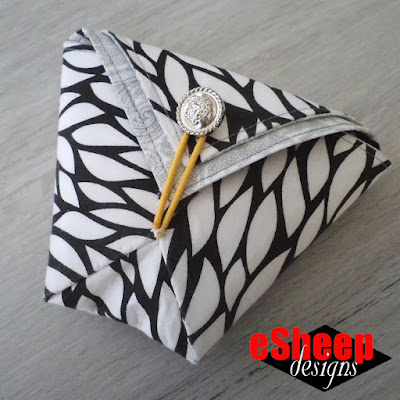 |
| A fabric origami pouch with — count 'em — six pockets! |
For as long as I can remember, I've been fascinated by the art of origami. There's something almost magical about a three dimensional object being created by folding a flat sheet of paper.
Being also a fan of applying origami to fabric (like this little origami ornament and this coin purse), I knew when I came across this idea that I had to give it a try and share it. It's a "choose your size" six pocket pouch that you can put together in about an hour if you're slow.
This would be a perfect travel or gift pouch for jewelry. The resulting pockets are relatively small and oddly shaped no matter how big you (are likely to) make this thing, so functionality is limited. But having six separate pockets in one unit for carrying jewelry is very useful.
Just to confirm: this is not my original creation and I take no credit for it apart from the ensuing instructions.
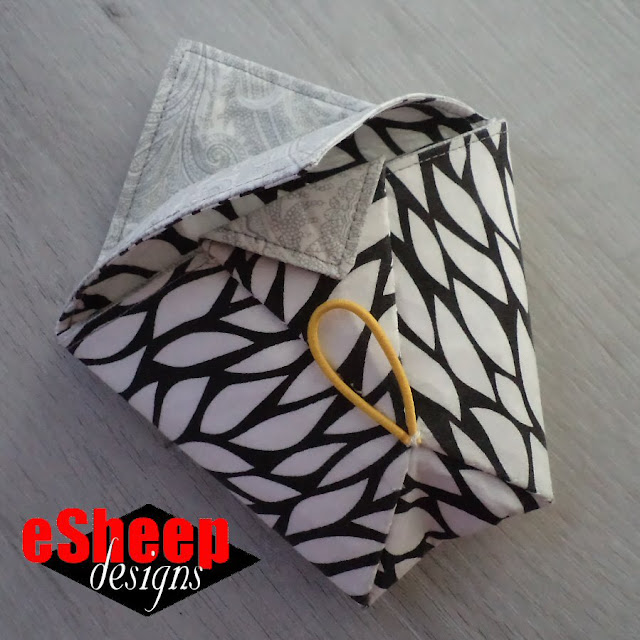 |
| Folded and sewn from a square... |
What will you need to make this? Two squares of fabric, light weight interfacing (if desired), a button, and an 8" or 20cm length of thin ribbon (length is suitable for the size of my sample project) or a hair elastic. And basic sewing supplies, of course.

Practice With Paper
There are a few versions of this fabric origami pouch around the web.
That said, the instructions that I came upon were confusing, so I decided to take a square of wrapping paper and prototype the project. The following twelve photographs illustrate how this pouch is created by starting with a square (of any size, but of course you realize that the smaller the square, the tinier the completed pouch).
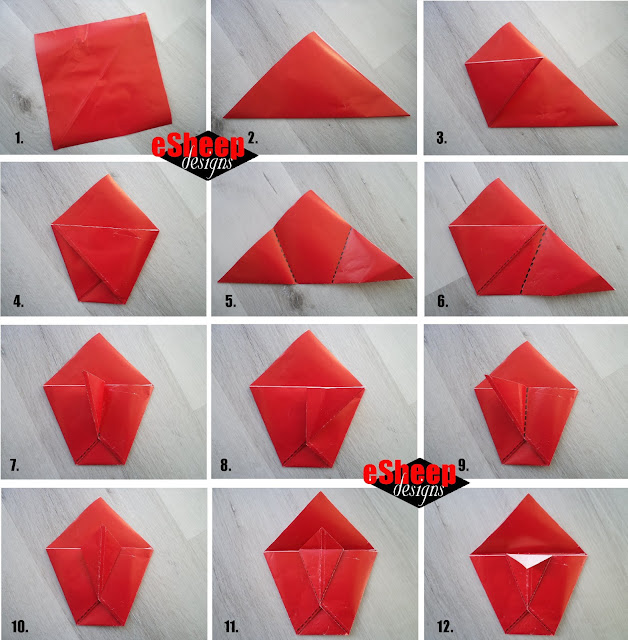 |
| The "how to" described in 12 pictures using a paper model... |
I used a couple of black markers to indicate where sewing is required; the dark thick dashed lines can be machine sewed and the lighter thinner dashed lines must be done by hand. It's obvious what layers are involved with the areas that can be sewn up by machine, but wherever you sew by hand, ensure that you are picking up just one layer of the pouch.
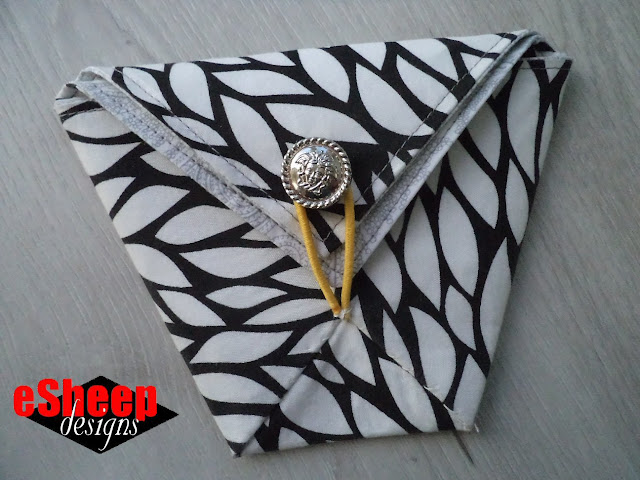 |
| The double flap design allows the finished pouch to show a sneak peak of the lining fabric... |
If you don't know what size you want to make this, creating a paper prototype is an excellent way of trying it on for size and getting in some practice with the folding part.
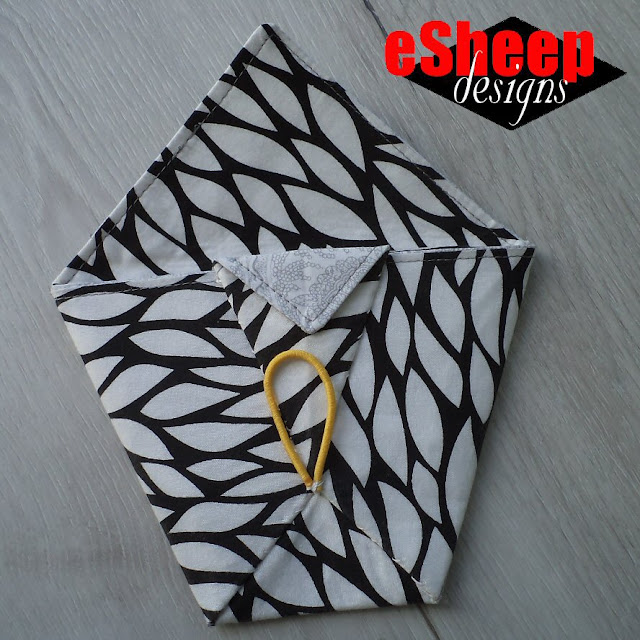 |
| View with both flaps open, showing a third "mini" flap... |
For the pouch shown here, I used two 11" (28cm) squares of fabric. (Why 11"? I took a couple of sheets of letter sized scrap paper and cut and taped together the biggest square template possible: 11" x 11".) The finished pouch measures 2.75" (7cm) wide along the base and is about 4.5" (11.5cm) high.
I interfaced one of the fabrics, the black and white one. It's a light weight microfiber (it comes from a duvet cover; the other fabric is from a pillow case) and doesn't hold up well on its own. Whether or not you want to interface will depend on overall size and choice of fabric.
Make the Base Fabric Square
The first step is to sew up your square base of fabric and press it well (figure 1 below). That is, put the two pieces of fabric (which may or may not be interfaced; it's your choice) right sides together, pin and sew all the way around the edge with a 1/4" (6mm) seam allowance (leaving a turning gap), snip the excess fabric from the corners, turn right side out, press and then topstitch.
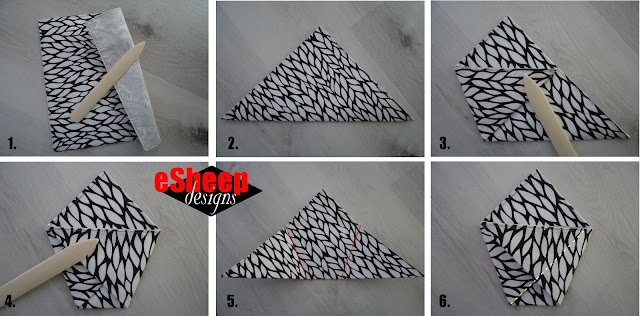 |
| Sew, fold, sew and (hand) sew... |
Make Basic Folds & Sew
The first diagonal fold creates an isosceles triangle out of the square of fabric (figure 2).
The second and third folds involve taking the two lower points of the triangle and folding them across to the other side as shown in figures 3 and 4.
For best results, use a folding tool and press with an iron after you make each fold.
Mark the inside of the two folds with a pencil and then sew along those lines (dashed lines shown in red in figure 5) with your sewing machine.
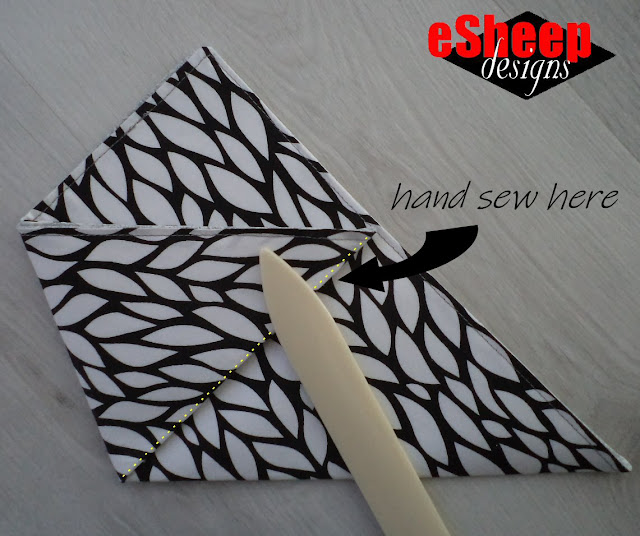 |
| Hand sew the folded edge (shown by the dashed line) to the first layer of the fabric square underneath... |
Hand sew the folded edge of the original left corner to the first layer of fabric as shown above (and also in figure 6), underneath the folded edge of the original right corner.
NOTE: If you are using ribbon as your preferred closure, fold the ribbon in half and sew the middle part of it underneath the edge here. Locate it at the intersection of the folded edges when the right corner is folded over on top (i.e.; exactly where you see the bottom of the hair elastic attached in the various photos here).
Make Squash Fold & Sew
This final fold is difficult to describe, but if you have any sort of experience with paper origami, you've likely done it. The loose (right) corner of the triangle that is currently just lying on top of the hand sewn (left) corner will be manipulated into a narrow, vertical triangular shape. This is done by first folding it back onto itself and then squishing — or squashing, hence the name — it down symmetrically.
 |
| Final folding and sewing... |
In between performing these two folds, however, you will machine sew one additional line, as shown in figure 8 above (the red dashed line).
The squishing (or squashing) down of that pointy piece is illustrated in figure 9. Ensure that both sides are even when you do this; your pouch should look symmetrical at each step of the process. (Remember to press with an iron for best results.)
There will be a point that can be folded down as a mini "flap" after this (figure 10). Before you worry about how to hold down that flap, however, follow the yellow dashed lines and orange pins in figures 11 and 12 to hand sew the vertical triangular shape in place.

Final Folding & Closing
All that remains is to fold and secure the flaps.
The little mini flap can be sewn down. (Or take the easy way out as I did: dab it with some hot glue.)
Fold the secondary flap snugly over the opening of the pouch. Then fold the top flap loosely over that. This creates the visual interest with the contrast lining fabric showing.
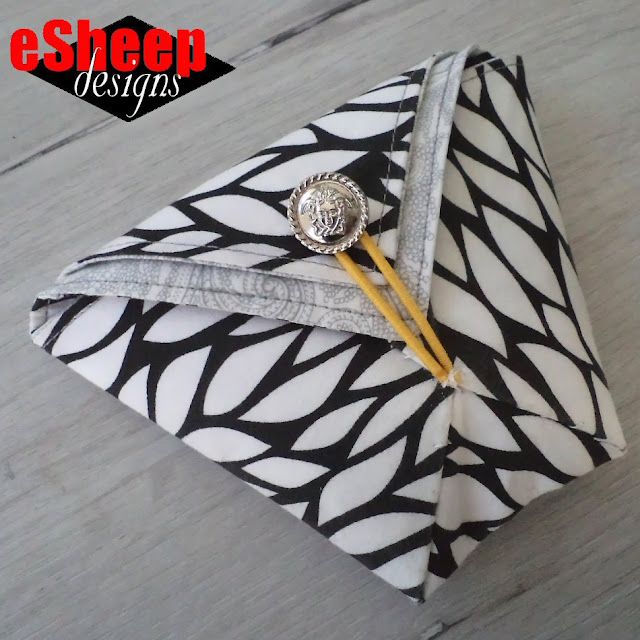 |
| Finished off with a button and an elastic... |
Press again with a hot iron.
Sew the button and hair elastic in place (if you didn't attach the ribbon earlier) and you've successfully created the six pocket fabric origami pouch.
Or is it actually seven pockets?
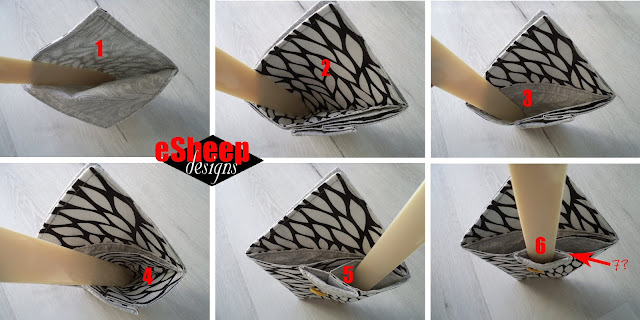 |
| Identifying the six — or is it seven? — pockets of this pouch... |
As I said at the beginning, some of the resulting pockets are quite small. The mystery seventh pocket is big enough for me to slip my pinky into, but as to what it would be good for? I dunno.
By the way, here is a side by side comparison of this pouch and one made with a 5" fabric square base.
 |
| An (un-sewn) mini version... |
Yes, it's tiny and the varying thickness of the layers may be problematic, but it still might be ultra-cute as a gift pouch for a necklace.
Want to know what my pouch is being used for? Well, after I made my DIY bobbins, the final piece of the puzzle dropped and I was inspired to turn this into a sewing kit.
 |
| Finally I have a sewing kit! |
In the first picture of pocket number #1, you see a pair of snips and my old seam ripper (I got a new one recently). Pocket #2 holds a small measuring tape. Pocket #3 holds one of my DIY bobbins complete with needles and thread. Attached to this bobbin are some buttons (stuck to cardboard bobbins with double sided tape) in pocket #5. (Pocket #4 is not currently being used.) Finally, there are three safety pins in pocket #6.
Up to now, I've not had an actual sewing kit for emergencies. (Unless you count those simple kits from hotel rooms.) This was therefore a worthwhile project with a useful outcome.
How big will you make your fabric origami pouch and what will you use it for?

Looks like a fun to make bag. I made a drawstring simple origami bag before once.
ReplyDeleteSuch a great sewing pattern.Thanks
ReplyDeleteYou're very welcome. Hope you enjoy making it.
Delete